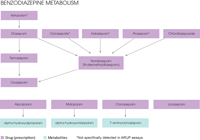Does the Father Get Drug Tested When Baby Is Born
Indications for Testing
Newborn drug testing is recommended in infants built-in to mothers with high-risk behaviors (eg, history of drug use/abuse, prostitution, nicotine employ), minimal or no prenatal care, or unexplained obstetric events (eg, placental abruption, premature labor).
Additionally, infants with unexplained neurologic complications, unexpected intrauterine growth retardation, or drug withdrawal symptoms (eg, NAS) should be tested for drug exposure.
Available Specimen Types
ARUP offers newborn drug testing for two specimen types: umbilical cord tissue and meconium. Urine equally a specimen blazon for neonatal drug testing has limited success; the start void is often missed because information technology may occur during or immediately subsequently delivery. Urine tests generally detect just recent maternal drug use in the days before delivery.
| Meconium | Umbilical String Tissue |
|---|---|
| First stool of the newborn Begins to course at ~12-16 wks gestation Accumulates over residue of pregnancy (nonlinear process) Usually passes within 48 hrs of nascence Used for drug testing for ~25 yrs Collection requires coordinated efforts and may not be available Drug detection in meconium depends on many factors (eg, quality and completeness of collection, drug apply patterns) | Forms ~5th wk of gestation Grows with fetus throughout pregnancy (nonlinear procedure) Easy to collect at time of nascence Drugs appear to eolith consistently across length of cord Concentrations of drug analytes are lower in string than in meconium, only can be detected with advisable methodology Drug detection in cord tissue depends on many factors (eg, quality and completeness of drove, drug use patterns) |
| Note: Umbilical string tissue and meconium drug tests are performed to support clinical and social management decisions and do non usually require chain of custody. ARUP offers a specimen tracking grade for documentation of the collection, handling, and shipping of specimens. Contact ARUP Client Services for more data. Sources: Wabuyele, 2018 ; Wu, 2018 | |
At that place are several factors to consider when deciding whether to use umbilical cord tissue or meconium for drug testing.
| Factors to Consider | Umbilical Cord Tissue | Meconium |
|---|---|---|
| Preferred process for collection is at birth, for all infants; test immediately for high-gamble births, store for low-risk births | ✔ | |
| Collection based on need (eg, history of drug exposure, maternal urine screen results, NAS symptoms/diagnosis) | ✔ | ✔ |
| Tracking of specimen collection and handling process required | ✔ | ✔ |
| Fastest available fourth dimension to result when positive results are expected | ✔ | |
| Traditional testing approach (screen with reflex to confirmation testing) preferred | ✔ | |
| Most sensitive and definitive testing for cannabis apply | ✔ | |
| Almost sensitive and definitive testing for heroin employ | ✔ | |
| Preferred for the detection of gabapentin, fentanyl, meperidine, propoxyphene, tramadol, tapentadol, phentermine, and/or zolpidem | ✔ | |
| Meconium specimen is limited or unavailable | ✔ | |
| Cord tissue specimen is limited or unavailable | ✔ |
ARUP Umbilical Cord Tissue Testing
Routine analysis by the ARUP drug detection panel includes qualitative detection by mass spectrometric methods for all compounds (eg, opioids, stimulants, sedative-hypnotics). The presence of metabolites improves conviction in results and lengthens the detection window. Umbilical cord testing is thought to reflect maternal drug utilise during approximately the last trimester of a total-term nascency. Tests to detect marijuana metabolite and ethyl glucuronide (booze metabolite) are available separately from the panel.
Farther Resources
- Umbilical cord tissue collection instructions
- Umbilical cord tissue collection video
- Test Fact Sheets: ARUP Drug Detection Console, Umbilical Cord Tissue (Qualitative) and Ethyl Glucuronide, Umbilical Cord Tissue, Qualitative
ARUP Meconium Testing
Routine analysis by the ARUP panel test includes a qualitative screen for nine drug classes; specimens that test positive for one or more drugs are reflexed to confirmatory testing by highly sensitive and specific mass spectrometric methods. Directed (confirmation merely) tests are available when only 1 drug course is of clinical interest or when the quantity of meconium available for testing is very pocket-size (ie, <one g).
The console is the preferred meconium test to detect and document maternal drug utilize during pregnancy (approximately the final trimester of a total-term birth). Targeted unmarried drug-grade testing is advisable if only a item drug grade or classes are of clinical interest, or when the quantity of meconium available for testing is very small (ie, <1 g).
Evaluation and Interpretation of Results
Drugs administered to the mother during labor and commitment may be detected in meconium or umbilical string tissue. Drugs administered to the newborn afterwards nascence may be detected in meconium if the meconium is collected subsequently drug administration.
Negative results do not exclude the possibility that the female parent used drugs during pregnancy; only the drugs targeted by the testing tin be detected. Maternal history and urine testing may likewise identify a possible baby drug exposure and should exist used in combination with other laboratory results and the infant's clinical presentation to diagnose a drug exposure.
Specimen variations tin contribute to simulated-negative results. When definitive analytical methods (eg, liquid chromatography-tandem mass spectrometry [LC-MS/MS], gas chromatography-mass spectrometry [GC-MS]) are used, false-positive results are extremely unlikely.
Refer to the Drug Testing topic for test consequence interpretation organized by drug class.
Farther Resource
Opioid Metabolic Pathway

Benzodiazepine Metabolic Pathway

Does the Father Get Drug Tested When Baby Is Born
Source: https://arupconsult.com/content/newborn-drug-testing